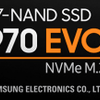Introduction
Samsung 970 EVO M.2 NVMe SSD (512GB)
Dotting the I's and crossing the T's
Samsung releases the new 970 EVO and PRO models M.2. SSDs, these offer even faster than the 960 series and come with increased TBW values as well. The new M.2 EVO units will be the most popular ones for the desktop end-users, and can be purchased in volume sizes up-to 2TB. NVMe Storage technology is advancing with extremely fast paces and steps. Oh my, NVMe Storage technology has been with extremely fast paces and steps as we now already reach the 970 series from Samsung. Armed with 64-layer (3-bit per cell) NAND flash memory, DRAM caching the new 970 series are based on the Samsung Phoenix controller, which have been introduced in there OEM PM981 already. Phoenix really is the Samsung Polaris Gen 2 controller now delivering up-to 3,500 MB/s sequential read speeds on even the smaller 500 GB and 1 TB versions, with up-to 2,500 MB/s sequential writes for the EVO series. For a little more shock and awe, Random 4KB numbers run up to 500,000 IOPS read and 480,000 IOPS write, which is pretty crazy.
The 970 EVO has been fitted with 64-layer3-bit per cell (written NAND. Today we will focus on that new EVO model, we have received a 500GB model for testing. The product is only slightly slower compared to the PRO model (which can do 2700 MB/s writes). Samsung is to release the new 970 EVO model in capacities of 250 GB, 500GB but also a 1 and 2TB volume sizes. Performance wise you'll get a smile on your face.
The precise performance values differ slightly per model/volume size though, we'll discuss and show you that on the next page. The 970 series is available in an M.2 (NGFF-2280) form factor (8cm). These units obviously will require PCI-Express 3.0 with x4 lanes as the SSDs are using the latest iteration of the NVMe protocol. The Samsung 970 EVO still offers plenty of endurance, depending on volume size 600 Terabytes written (TBW) for the 1 TB capacity, half that for the 500 GB version and again half of that (150TB) for the 250 GB model. The EVO series will receive a five-year warranty (or the TBW value - whichever one comes first). These new M.2 units use the NVMe protocol and that means storage technology at hyper-fast speeds while remaining competitive in pricing. The model we test today is capable of passing that 3.5 GB/s marker for reads and close to 2500 MB/second sequential on writes. The Samsung 970 EVO SSD is Samsung’s last generation consumer-ready Non-Volatile Memory Express (NVMe) M.2 form factor SSD with vertical NAND (V-NAND) technology (64 layers/256Gb & stacked). Storage technology keeps advancing at the fast pace it does, the performance numbers a good SSD offers these days are simply excellent as you can reach say 450 MB/s to 500 MB/sec on SATA3 which is the norm for a single controller based SSD. Next to that, over the past year, NAND flash memory (the storage memory used inside an SSD) has become much cheaper as well.
Samsung’s new 970 EVO/PRO M.2 product line is powered by the company’s Phoenix controller. All models follow a smaller M.2 2280 form factor so it will fit on most ATX motherboards capable of M.2 just fine (or just use a PCI-Express daughter card but make sure you have x4 Gen 3.0 lanes available for it). IOPS numbers are in that 500K for read and writes marker (depends on volume size). At just one-tenth the weight of a traditional 2.5-inch SSD, the M.2 SSDs are ideal for users looking to upgrade their desktop or ultra-thin PCs with high-capacity, high-performance storage. Usability and compatibility then - remember, you do need a modern motherboard with capable NVMe supported M.2 (PCIe Gen 3.0 x4 lanes connected) interface though, please do check out your motherboard manufacturer for that. Yeah, have a peek, and then let's head onwards into this review.


